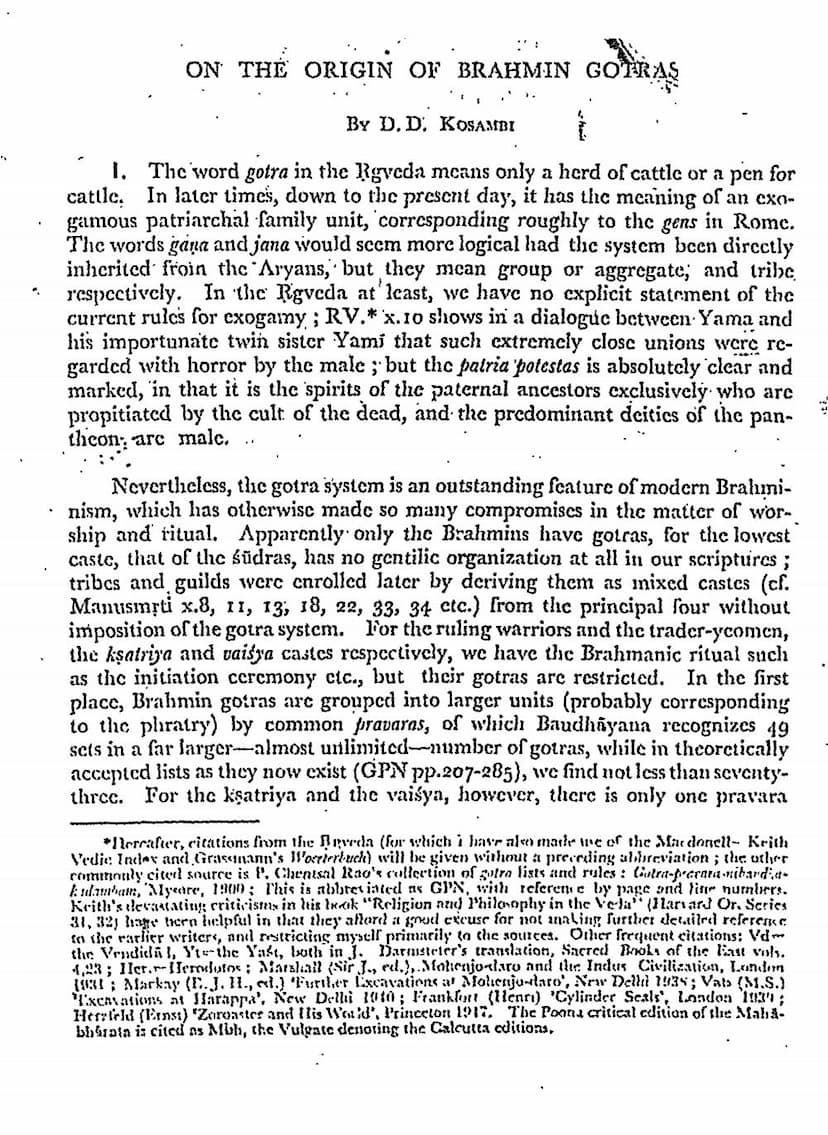Origin Of Brahmin Gotras
Added to library: September 2, 2025

Summary
Here's a comprehensive summary of D. D. Kosambi's "Origin of Brahmin Gotras," based on the provided text:
Central Thesis:
Kosambi argues that the Brahmin gotra system, far from being an ancient and inherent Aryan institution, is a later development, primarily adopted and adapted by various pre-Aryan and non-Aryan groups who integrated into the evolving Brahmin priestly class. This adoption process led to the complex and sometimes contradictory nature of the gotra system as observed today.
Key Arguments and Evidence:
-
Evolution of "Gotra": Kosambi begins by establishing that the word "gotra" in the Rigveda originally meant a "herd of cattle" or a "pen for cattle." Its later meaning, an exogamous patriarchal family unit, emerged much later and is distinct from its Vedic usage.
-
Brahmin Institution: The gotra system, in its evolved form, is primarily a Brahmin institution. While extended to the Kshatriya and Vaishya castes, this was due to Brahminical superiority, and their gotras are often derived from their priestly family's gotra. The Shudras, according to scriptures, do not have this organized system.
-
Shift from Totemism to Sage Names: Unlike the totemistic or animal-based lineage markers of earlier tribal societies, Brahmin gotras are consistently derived from the names of ancient sages. Kosambi suggests this was a deliberate re-styling to legitimize and assimilate new groups.
-
Historical Assimilation, Not Originality: Kosambi proposes that the gotra system originated not from the original Aryan invaders, but from the assimilation of pre-Aryan or non-Aryan priestly groups. These groups, taking on priestly functions for the Aryans, were logically assigned to the patriarchal clan-groups of those they served, thus acquiring the same gotra. The rule later reversed, with priests' gotras dictating the ruling class's, as Vedic Kshatriyas declined and new warrior classes emerged.
-
Confusions and Discrepancies in Gotra Lists: The author highlights the inconsistencies and "double gotras" (cases where an individual belongs to two distinct gotra groups) found in later Brahminical lists. He attributes these not to oversight but to the ongoing process of recruitment and assimilation of new members into the priesthood at various stages. Examples include Gotamas and Bharadvajas being grouped under Angirasas, and the complex relationships between names like Kāśyapa, Kanva, and Viśvāmitra.
-
The Role of Kshatriya Priests and Rși-Kings: Kosambi points to figures like Viśvāmitra, who is described as a rjarși (royal sage), suggesting a tradition where Kshatriyas also held priestly functions. The rivalry between Viśvāmitra and Vasiṣṭha is presented as a key instance of shifting power dynamics, where Vasiṣṭha, initially a priest for King Sudās, later displaces Viśvāmitra, implying a later Brahminization of a previously Kshatriya priest.
-
Pre-Aryan Roots of Religious Concepts: Through detailed analysis of Rigvedic hymns and comparative mythology, Kosambi argues for the significant influence of pre-Aryan cultures on early Vedic religion.
- Tvaṣṭr: This creator-god, associated with crafts and embryos, is presented as a likely pre-Aryan deity, adopted into the Vedic pantheon. His multiple heads and associations with rivers suggest a connection to matriarchal traditions and local cults.
- Mother Goddesses and Matriarchy: Kosambi highlights Vedic references to multiple mothers giving birth to a single child or god (e.g., Soma, Agni, Skanda) as evidence of surviving matriarchal customs from pre-Aryan populations. These are later reinterpreted or rationalized within a patriarchal framework.
- Deities with Multiple Heads/Faces: The presence of multi-headed deities and animals in Indus Valley seals is linked to Vedic figures like Trisiras Tvaṣṭra, Bṛhaspati, and Brahmā, suggesting shared cultural origins or influences.
- Sarasvati: The goddess Sarasvati, initially a river deity, is shown to have strong connections to "mother" concepts and possibly pre-Aryan riparian urban cultures.
-
Conquest and Social Transformation: The Aryan conquest of the Indus Valley civilization is a crucial backdrop. Kosambi argues that the conquest, while violent, also led to the absorption of pre-Aryan elements, including their priesthood. This absorption accelerated the development of the caste system and solidified the Brahminical ritualistic dominance. The subjugation of the "Dasyus" or "Dasas" (often portrayed as enemies, non-fire-worshippers, and dark-skinned) is seen as the origin of the Shudra caste.
-
The "Inversion" of Tradition: A recurring theme is the "inversion" of historical reality in later Brahmanical tradition. What might have been the original situation (e.g., pre-Aryan priests adopting Aryan practices) is presented in a reversed manner in later texts to glorify the Brahmins and their lineage.
-
Iranian Parallels: Kosambi draws parallels with Iranian society, particularly the Magi and the Atharvans, noting similar developments of a priestly caste and the adoption of ritualistic practices. This comparison supports the idea that these processes were not unique to India.
Conclusion:
Kosambi concludes that the Brahmin gotra system is a product of historical assimilation and adaptation, rather than an original Aryan inheritance. The system evolved through the incorporation of diverse pre-Aryan and non-Aryan groups into the Brahminical priesthood, leading to a complex overlay of traditions and names. The Rigveda, when interpreted critically and in conjunction with archaeological evidence and comparative mythology, reveals the dynamic and often assimilative nature of early Indian religious and social development. The core argument is that Brahminism itself arose from the adoption of indigenous pre-Aryan priests by the Aryan invaders.